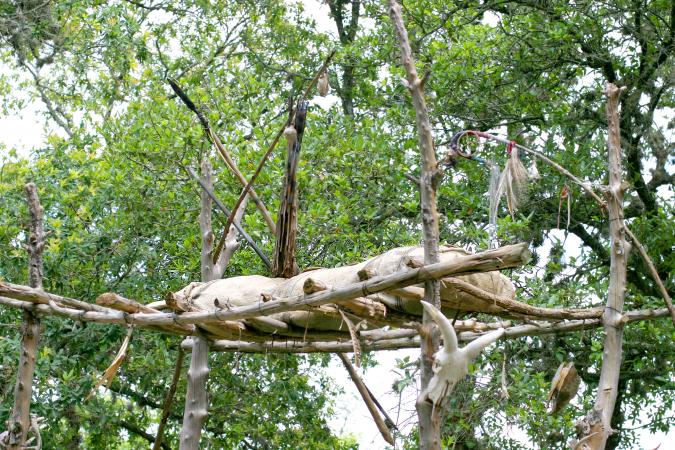 Most Native American tribes believed that the souls of the dead passed into a spirit world and became part of the spiritual forces that influenced every aspect of their lives. Many tribes believed in two souls: one that died when the body died and one that might wander on and eventually die.
Most Native American tribes believed that the souls of the dead passed into a spirit world and became part of the spiritual forces that influenced every aspect of their lives. Many tribes believed in two souls: one that died when the body died and one that might wander on and eventually die.
Burial customs varied widely from tribe to tribe. Indians disposed of their dead in a variety of ways. Arctic tribes, for example, simply left their dead on the frozen ground for wild animals to devour. The ancient mound-building Hopewell societies of the Upper Midwest, by contrast, placed the dead in lavishly furnished tombs. Southeastern tribes practiced secondary bone burial. They dug up their corpses, cleansed the bones, and then reburied them. The Northeast Iroquois, before they formed the Five Nations Confederation in the seventeenth century, saved skeletons of the deceased for a final mass burial that included furs and ornaments for the dead spirits’ use in the afterlife. Northwest coastal tribes put their dead in mortuary cabins or canoes fastened to poles. Further south, California tribes practiced cremation. In western mountain areas tribes often deposited their dead in caves or fissures in the rocks. Nomadic tribes in the Great Plains region either buried their dead, if the ground was soft, or left them on tree platforms or on scaffolds. Central and South Atlantic tribes embalmed and mummified their dead. But during outbreaks of smallpox or other diseases leading to the sudden deaths of many tribe members, survivors hurriedly cast the corpses into a mass grave or threw them into a river.
Rites among Native Americans tended to focus on aiding the deceased in their afterlife. Some tribes left food and possessions of the dead person in or near the gravesite. Other groups, such as the Nez Perce of the Northwest, sacrificed wives, slaves, and a favorite horse of a dead warrior. Among many tribes, mourners, especially widows, cut their hair. Some Native Americans discarded personal ornaments or blacked their faces to honor the dead. Others gashed their arms and legs to express their grief. California tribes engaged in wailing staged long funeral ceremonies and held an anniversary mourning ritual after one or two years. Southwest Hopi wailed on the day of the death and cried a year later.
Some Southwestern tribes, especially the Apache and Navajo, feared the ghosts of the deceased who were believed to resent the living. The nomadic Apache buried corpses swiftly and burned the deceased’s house and possessions. The mourning family purified itself ritually and moved to a new place to escape their dead family member’s ghost. The Navajo also buried their dead quickly with little ceremony. Navajos exposed to a corpse had to undergo a long and costly ritual purification treatment.
Read more: http://www.deathreference.com/Me-Nu/Native-American-Religion.html#ixzz5d4EoTf6x
Choctaw Bonepickers
Among the honored officials of the Choctaws were men – and possibly women – who were known as bonepickers. These undertakers were tattooed in a distinctive manner and allowed their fingernails to grow long for their revolting occupation. When the body had remained upon the scaffold the specified time, a bone-picker was summoned, and all the relatives and friends were invited for the last rites.
These mourners surrounded the scaffold, wailing and weeping, while the grisly undertaker ascended the platform, and with his long fingernails thoroughly cleaned the bones of the putrefied flesh.
The bones were then passed down to the waiting relatives, the skull was painted with vermilion, and they were carefully placed in a coffin curiously constructed of such materials as bark and cane. The flesh was left on the platform, which was set on fire; or was carried away and buried.
Episode Guest
Jonathan Henderson
Johnathan holds a Bachelor’s degree in Psychology and has been researching Native American mortuary customs for three years. He is an old soul and generally prefers the company of animals. His unique visionary approach to the subject allows insightful understanding of history and anthropology.
.
 Death Investigator Magazine
Death Investigator Magazine
A digital magazine focused on the death investigation community. Dedicated to improving skills and enriching lives of investigators.
 Medicolegal Death Investigation – Online Academy
Medicolegal Death Investigation – Online Academy

The Death Investigation Training Academy was founded to play an integral role in the death investigation community. The need for quality accredited training is in short supply and high demand. Using a combination of classroom training, live on site scenario exercises, and web-based training, the Death Investigation Training Academy is filling the need of 21st-century investigators.

coroner,police training, darren dake,sheriff,deputy,coroner association,murder scenes,auto fatalities,csi,first responders,autoerotic fatalities,become a coroner,forensic science crime scene investigation,forensic science crime,scene investigator,forensic training,forensics training,how to be a crime scene investigator,how to become a death investigator,how to become a medical examiner,how to become a medical examiner investigator,medical examiner investigator training,medical investigator training,medicolegal death,medicolegal death investigator training,murder scenes,pictures of murder scenes,murder,real murder crime scenes,traffic deaths,traffic fatalities,what does it take to be a coroner,what does it take to be a criminal investigator,firefighter,fire training,firefighter training,autoerotic fatalities,become a coroner,coroner information,crime scene clean up training,crime scene cleaning training,crime scene cleanup training,crime scene investigation,crime scene investigation classes,crime scene investigator courses,crime scene investigator school,crime scene jobs,crime scene photography,crime scene photography training,crime scene technician,crime scene technician training,crime scene training,criminal investigation,criminal investigator,criminal justice,criminal justice forensic science,criminal justice forensics,criminal scene investigation,death crime scenes,death investigation training,death investigator training,death investigators,forensic death investigator,forensic investigator,forensic photography, crime scene clean up,crime scene bio-hazard, using plants in criminal investigation,forensic botany,dr.jane bock,death investigator magazine,dr judy melinek,badge of life,american college of forensic examiners,acfei,american board of medicolegal death investigators,abmdi,matthew lunn,underwater crime scene,mike berry


 This exclusive first of its kind Medicolegal Death Investigation (MLDI) kit contains all the items you need to document and collect evidence from the most important piece of evidence at any death scene – The Body. Designed for Coroners, Medical Examiner Investigators, and anyone responsible to investigate and process a death.
This exclusive first of its kind Medicolegal Death Investigation (MLDI) kit contains all the items you need to document and collect evidence from the most important piece of evidence at any death scene – The Body. Designed for Coroners, Medical Examiner Investigators, and anyone responsible to investigate and process a death.